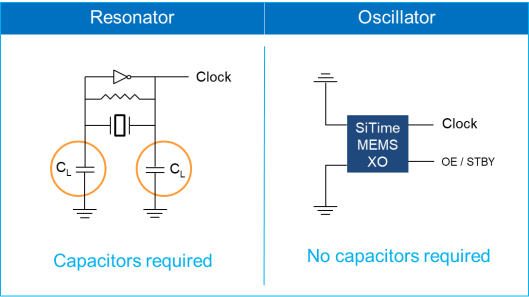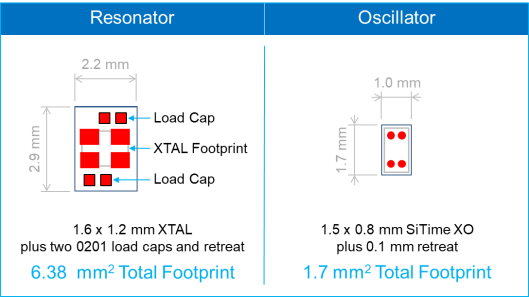 The current wait time for capacitors is up to a year or more, creating backlogs and forcing companies to push out timelines. And industry experts expect the shortage to get worse before it gets better, with predictions it will last beyond 2020. This forecast is prompting many to find new strategies to reduce the dependence on capacitors. Using oscillators instead of resonators can help fix this problem, along with curing other design issues.
The current wait time for capacitors is up to a year or more, creating backlogs and forcing companies to push out timelines. And industry experts expect the shortage to get worse before it gets better, with predictions it will last beyond 2020. This forecast is prompting many to find new strategies to reduce the dependence on capacitors. Using oscillators instead of resonators can help fix this problem, along with curing other design issues.
Here’s why replacing quartz crystal resonators (XTALs) with oscillators is a better solution.
1. Unlike resonators, oscillators don’t require load capacitors
No need for a capacitor means not waiting for parts.
Most resonators require load capacitors to provide phase shift and sustain oscillation. Oscillators, on the other hand, combine a resonator and an oscillator IC with on-chip capacitance, into one package. This ensures that the resonator and oscillator circuit are matched, eliminating the need for external capacitors to tune the resonate frequency. In addition, SiTime 32 kHz MEMS oscillators don’t need power supply decoupling capacitors.

2. Oscillators take less space
The smallest crystal resonator, along with its required capacitors, consumes over 6 mm2 of board space. In contrast, the smallest MEMS oscillator takes only 1.7 mm2 of total board space, effectively shrinking the footprint to less than one-third the size.

And if you’re using a 32 kHz 2012 XTAL, you can use a pin-compatible 2012 MEMS oscillator and simply skip the capacitors since on-chip capacitance is integrated.
The timing footprint and BOM can be further reduced by using an oscillator since it’s an active circuit with an output driver that can drive two to three loads depending on the drive strength. This allows a single oscillator to replace multiple crystals and their associated capacitors.
3. SiTime oscillators are available now
Most resonators are useless without capacitors which remain in short supply. SiTime oscillators, however, are available now. And they come in any frequency, any voltage, and any stability within a wide operating range.
While components such as capacitors and crystal resonators use specialized materials and processes, SiTime MEMS oscillators use standard semiconductor packaging and processes. Leveraging the huge semiconductor infrastructure – with its immense capacity, a multitude of vendors and fabrication facilities, and compatible processes – results in an extremely robust supply chain for producing silicon MEMS oscillators.
Additionally, SiTime oscillators are designed with a programmable architecture. Blank MEMS oscillators are produced in large volumes, held in inventory, and are programmed to customer specifications. Manufacturing MEMS oscillators with standard processes and materials, combined with programmability, enables enormous flexibility, massive scalability, and ultra-short lead times.
Find pre-programmed SiTime oscillators at your distributor. Or get a Time Machine II programmer ($200) and blank oscillators to instantly program parts in your own lab.
To learn more about the benefits of oscillators, see our white paper: The top 8 reasons to use an oscillator instead of a crystal resonator
-----------------------------
Thanks to Bruce Potvin, VP of Global Channel Sales, and Jim Holbrook, Director of Customer Engineering at SiTime, for their contributions to this article.